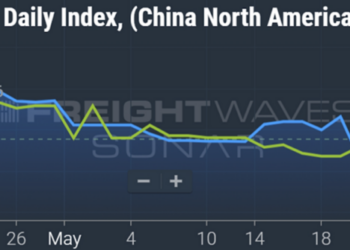WASHINGTON — The Biden administration’s pick to head the first high-level cabinet office dedicated exclusively to freight is setting a high bar for the value her office will bring to the nation’s freight markets.
Allison Dane Camden will lead the U.S. Department of Transportation’s new Office of Multimodal Freight Infrastructure and Policy as the first deputy assistant secretary for the office.
Camden brings to the office experience she gained at the Washington State Department of Transportation when she served as deputy assistant secretary for multimodal development and delivery.
The stakes at the U.S. DOT are higher. Camden is tasked with coordinating national freight policy with all 50 states, creating a National Multimodal Freight Network (NMFN), and overseeing a data portal that has figured out how to get cargo owners and carriers to share their freight data in exchange for a deep look into the country’s supply chains.
Camden spoke with FreightWaves to outline her vision of what government agencies and private companies can expect from her office and from that data portal, Freight Logistics Optimization Works (FLOW), which the Biden administration launched in March 2022.
[This interview was edited for length and clarity.]
FREIGHTWAVES: Companies involved with moving goods through the nation’s freight networks, along with those that build and maintain those networks, have been anxious to see your office get up and running since it was authorized under the Bipartisan Infrastructure Law in 2021. What immediate benefits can they expect now that the office is officially underway with its first leader?
CAMDEN: Freight now has a permanent seat at the table. There’s been great work happening at U.S. DOT for a lot of years, but it has often been siloed, as departments can be. So this new office is housed within the office of the secretary and is really meant to lead on freight policy and knit together the good work that has already been happening.
So my goal for the freight office is to be a one-stop shop to tackle freight needs, collaborate with the other parts of DOT, with industry partners, and with state and local governments to strengthen the supply chain and ensure goods can move more efficiently. I think folks are going to start seeing that soon.
We’ve also got the National Multimodal Freight Network designation that’s part of the mission of this office. [Among the goals of the NMFN, required by Congress in 2015 but never finalized, is to prioritize investment in freight infrastructure.] We want to get that started in 2024.
And even before I got here the work of FLOW was underway. And we’re starting to see the fruits of that effort already, and that’s only going to grow with time.
FREIGHTWAVES: Speaking of FLOW, what is your vision for that initiative?
CAMDEN: I see it as an innovative solution to a pretty pernicious problem that came up during the supply chain crisis.
Two years ago when some were saying Christmas was going to be canceled, the Biden administration and this department brought together the private sector partners of the supply chain and the public sector partners of the states and local governments and ports to solve that problem.
Christmas wasn’t canceled. People received 99% of their packages on time from major shippers. Part of what we saw and what we were consistently hearing at that time was that we didn’t just need better physical infrastructure, we also needed better data infrastructure. So that’s what FLOW is aiming to get at.
We’re seeing great results so far. We just had the first tranche of data go out to our private sector partners, and they’re starting to be able to put it to use, to add it to their own models to aid their decision-making, and we’re getting positive feedback from them.
FREIGHTWAVES: There are some big players notably absent from FLOW’s current 59-member participant list, including two of the major Class 1 railroads [Norfolk Southern and CSX], and there are just a handful of trucking companies. Is FLOW’s effectiveness hindered given the amount of freight capacity represented by these and other carriers that are not yet part of the platform?
CAMDEN: I don’t think that’s hindering it at all. We always intended to start small and grow, so I’m proud of what the team’s done in such a short amount of time — it hasn’t even been two years. We currently have 65% of all [import container] bookings — no one else has that. We have the top five U.S. container ports, all the major chassis providers, seven of the major ocean carriers, four of the largest importers.
This is unprecedented. To me it is so impressive to see the federal government and the private sector partner together in this way. This is proprietary data, but we found a way to make the private sector comfortable sharing it, knowing that it’s going to be for a greater good that’s going to help them and the overall supply chain.
Participants are already using the data and are excited about it. We think more industry partners will be interested in joining as they see the real-world value.
FREIGHTWAVES: Will nonparticipants, or the general public, be able to tap into FLOW and see the data?
CAMDEN: The system was meant to work so that if you share your data, you get data back out that can be used for decision-making, so only those participating will have access. But anyone will be able to access the demo once it’s up and allow them to understand how the system works.
FREIGHTWAVES: The FLOW website indicates that an interactive portal demo is “coming soon.” When can we expect to see that?
CAMDEN: It should be available by early next year.
Related articles
Biden administration announces massive logistics plan
Where is DOT’s Freight Office?
DOT rolls out National Freight Strategic Plan
Click for more FreightWaves articles by John Gallagher.
The post DOT’s freight data exchange processing 65% of US container imports appeared first on FreightWaves.














